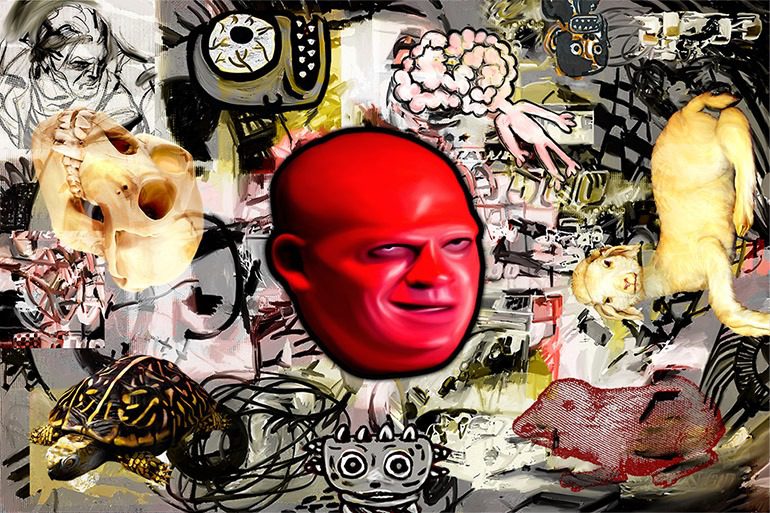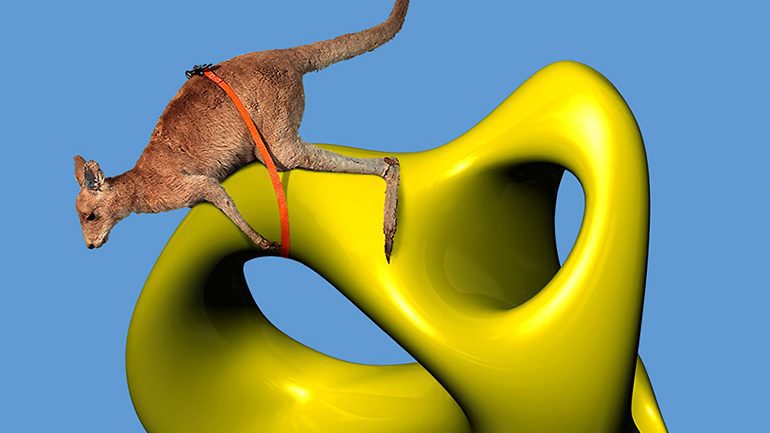ART NEWS
Roland Faesser, No More Jumping , mixed media, height 220 cm (7 ft) / © Roland Faesser 2009
CONCEPTUAL ARTIST
Sculptures and Prints by Roland Faesser are humorous and powerful . Artcentron celebrates this Zurich based artist for his subtle yet poignant artistic statements

Roland Faesser, Cherry Head, print on canvas / max. size = 300 x 450 cm (10 x 15 ft) / © Roland Faesser 2013
BY KAZAD
ZURICH, SWITZERLAND — Jeff Koons, the conceptual contemporary artists whose Orange Balloon Dog sculpture sold for $58.4 million at Christie’s art auction in New York recently, is a major source of influence for many artists across the globe. Following in the path of Marcel Duchamp’s Dadaism with focus on readymade, Koons has made a name for in the art world.
Like Koons Roland Faesser also explores readymade and appropriate common place objects in his works. Faesser’s works are unique and thought provoking. His prints on canvas are characterized by a confluence of images on which a dominant iconic image is superimposed. In his prints on canvas, Faesser combines images of animals, skeletons, buildings, and many other objects to create collages that serve as background for many of his works. On these very busy patchwork filled with movement, he superimposes a dominant image.
Many of Faesser’s collaged backgrounds seem to express the internal emotions of the dominate image. In Cherry Head, for instance, the head of a man with a mischievous smile on his face is superimposed over images of turtle, rodents, skull, and some anthropomorphic images. These images are very symbolic as they reference the character of the man, who is evidently a flamboyant, corny and dangerous man.
Faesser’s appropriation of everyday objects and readymade are vivid in his sculptures. His sculptures and trophies made of inflatables and found objects are witty and provocative. In Roberto Blanco, a mixed media sculpture, Faesser pokes fun at Roberto Blanco, the only black German Schlager singer. Schlager is an entertainer music or German hit mix that emerged in Europe after the Second World War as a response to American rock and roll. As an entertainer, Blanco who wears an Afro wig has the tendency to open his eyes wide during performances and discussions. Those characteristics are the point of Faesser’s humorous reference, which draws a similarity between the musician and Kermit the Frog. Faesser’s sculpture has the head of a deer. On the deer’s head are mini-sculpture of an ant, Kermit the Frog and other found objects.
Faesser’s amazing ability to make poignant comments in such a playful way is why Artcentron celebrates him. In his sculpture and art prints, he communicates emotional messages in a very subtle and humorous manner. In Ceci n’est pas un Koons (This is not a Koons), for instance, Faesser seems to contest the idea of art commodification while also emphasizing that appropriation of common place objects is an integral part of contemporary art. For Faesser, however, appropriation must be done correctly to effectively communicate ideas. Ceci n’est pas un Koons proves this point. With it, Faesser pokes fun at Koons who is often criticized for his banality and wanton copying of everyday objects all under the guise of appropriation.
ARTCENTRON CELEBRATED | READ ALSO: Canadian Artist Anne-Marie Cosgrove Questions Limits of Narrative
Artist Biography
Born in Lima Peru, Roland Faesser studied architecture in Switzerland. Over the years he has worked as professor, instructor and art critic in many art and architecture institutions across the globe. Some of the institutions where Roland Faesser has worked as art instructor, lecturer and art critic include Swiss Federal Institute of Technology Zurich, F+F Art School in Zurich, University of Art and Design Zurich (ZHdK), Saint Martins College of Art & Design in London, and Academy of Design in Vorarlberg, Austria. His works have also been shown in museum and galleries across the globe. You can see more of Faesser’s works at http://www.faesser.com/

Roland Faesser, Hula Hoop, Collection Hauser & Wirth / mixed media, height 110 cm (3.6 ft) / © Roland Faesser 1988

Roland Faesser, Ceci n’est pas un Koons, mixed media, height 130 cm (4.3 ft) / © Roland Faesser 2007

Roland Faesser, Fishing Clouds, mixed media (original trophy) / height 130 cm (4.3 ft) / © Roland Faesser 2006













